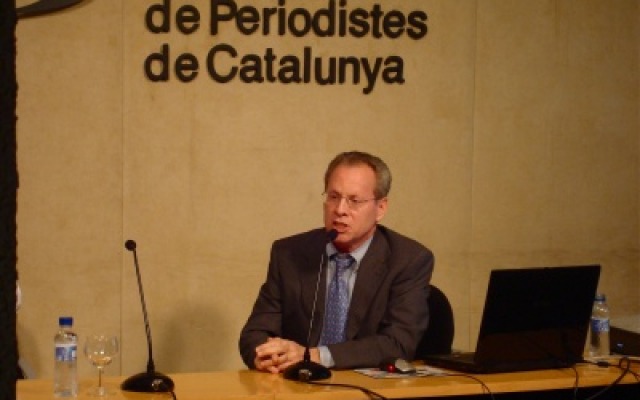research
13th Barcelona Economics Lecture Features Robert J. Barro

On April 3 at 19.00, Harvard Professor Robert Barro spoke about “Macroeconomic Crises since 1870” at the Centre Internacional de Premsa de Barcelona.
The talk was the 13th in the Barcelona Economics Lecture series organized by the GSE Research Network. Over 50 students, professors, and researchers affiliated with the community were in attendance.
The event began with a brief introduction by Jaume Ventura, GSE Affiliated Professor and CREI Senior Researcher. Professor Barro, who is Paul M. Warburg Professor of Economics at Harvard University and, according to IDEAS/RePEc, among the 10 best economists in the world, began his talk by describing why he initially became interested in examining how real disasters and crises affect the behavior of asset prices, consumption, welfare and other variables.
“Our initial idea was to expand on the Maddison data to include measures that were closer to the consumption concept that mattered to economic theory,” says Professor Barro, who used the data he previously in a 2006 study on rare economic disasters.
Together with Harvard PhD student José Ursua, Professor Barro set out to expand, revise and reformulate much of the available GDP data. The researchers identified 42 countries that could provide long-term information dating back to WWI, including 35 countries on GDP and for 22 on personal consumer expenditure. For samples that start as early as 1870, Professor Barro applies a peak-to-trough method for each country to isolate economic crises, defined as cumulative declines in per capita personal consumer expenditure or GDP by at least 10%.
In a global context at least since 1870, the most serious economic disaster in terms of incidence and severity of declines in per capita personal consumer expenditure and GDP was World War II. This event was followed in terms of economic impact by World War I and the Great Depression, the early 1920s (possibly reflecting the influenza epidemic of 1918-20), and post-World War II events such as the Latin American debt crisis and the Asian financial crisis.
Interestingly, Professor Barro found the US to be an outlier in many instances. “For example, during WWII the US grew like crazy with per capita GDP, while in many other countries this was a disaster period. There is then a demobilization following the war that causes a drop in GDP, but not in consumption. The US is possibly the only case in which we might accept the hypothesis GDP is fitted to a fixed trend line,” says Professor Barrow.
In addition to the most serious disasters, the researchers found 87 major crises for per capita personal consumer expenditure and 148 crises indicated by sharp declines in GDP, implying disaster probabilities around 3.6% per year with an average duration of 3.5 years.
Professor Barro went on to discuss an underlying theoretical model—the Lucas-tree model—to produce predictions about how rates of return should be determined. Employing a simulation of the model with i.i.d. growth shocks and Epstein-Zin-Weil preferences, the researchers initially constrained the fractional decline in real stock prices during a crisis to equal the measured fractional fall in consumption or GDP. A follow up simulation tracking actual changes in real stock prices during crises was in accordance with observed average returns on levered equity.
This first round of analyses opens the door for follow up analyses to answer further research questions. Professor Barro plans to conduct a statistical analysis that uses all the time-series data and includes estimation of long-run effects of crises on levels and growth rates of per capita personal consumer expenditure and GDP. He also intends to study the bond-bill premium and allow for time- varying disaster probabilities.
Though his contributions to the field of macroeconomics have been enormous, Professor Barro began his education intending to pursue a career in the physical sciences. He graduated with a B.S. in physics from the California Institute of Technology in 1965, but soon after realized that he would be more successful using his technical and math background to address social problems, according to an interview with the IMF F&D magazine. In 1970 he earned a Ph.D. in economics from Harvard University.
Professor Barro’s research is both extensive and varied, relevant to many of the economic and public policy debates, including business cycle theory, growth theory, the neo-classical synthesis and public policy. Boston University's Robert King, a former colleague of Professor Barro, cited him in the IMF’s F&D magazine as an “influential applied macroeconomist of his generation," because his impact stems not from a single contribution but from the fact that "in virtually every major area of the field you have to contend with a paper by Barro."
Professor Barro established his reputation with a 1974 paper "Are Government Bonds Net Wealth?” which is one of the most commonly cited articles in macroeconomics literature. Following this early success Professor Barro has continued to produce compelling research in a number of areas. He is well known outside of academia for his columns in the Wall Street Journal and Business Week. Barro has written a number of textbooks on macroeconomics and monetary policy, including a book, "Economic Growth", co-authored with GSE faculty member Xavier Sala-i-Martin.
